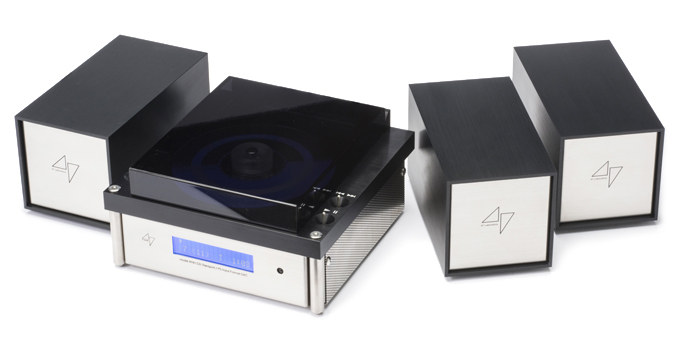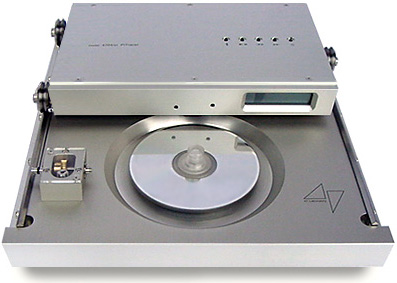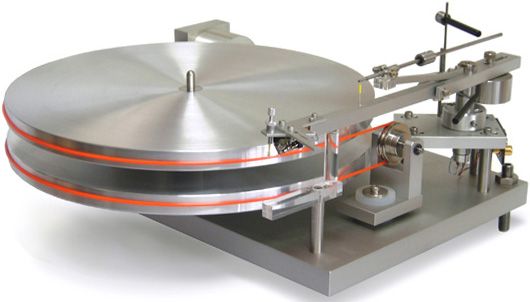Publisher’s note: Yoshi Segoshi of Sakura Systems, which is the North American Importer of 47 Laboratories from Japan, is the only company able to secure products from 47 Laboratories for sale in North America. Junji Kimura, president of 47 Laboratories, has also reached out to various online entities that are selling his products. He never received any response from these online websites. These companies have no actual inventory. Readers beware.
If you never had the chance to experience the $25,000 47 Laboratory PiTracer CD transport when it first came out at the turn of the century, then the company’s latest CD player, the 4741 Izumi will be one of a handful of machines on the market you’ll ever experience for the ultimate in Redbook CD playback, and your last chance to hear it before designer/engineer Junji Kimura retires. Costing nearly $9,000 and considering it doesn’t provide XLR outputs, nor an internally separated DAC functionality for USB, Optical or Coaxial inputting connectivity, the Izumi is not for the larger, general audiophile marketplace.
In fact, the Izumi only offers one pair of analog RCA output and one Coaxial digital output, and the latter outputs some of the purest Redbook digital signal I’ve heard from a transport. Still, the Izumi is only for two types of customers that I can see: Readers wishing only to contend with Redbook CD playback and nothing else, and those already possessing playback systems for the myriad of formats and adding a top-sounding CD player for $9,000 is part of the plan. As a reviewer, it’s necessary for me to investigate and venture into multiple formats, but I can just as soon relate with the connoisseur who amassed a vast and cherished collection of CDs and have no desire to begin the process of amassing the same content in other formats anew.
This Redbook CD-only insistence exits only in two companies and two individuals, Peter Qvortrup of Audio Note UK and Junji Kimura of 47 Laboratory of Japan. Both companies believe the full potential of CD playback was not exploited to the fullest when the rest of the industry embarked upon oversampling and upsampling as empowered by the ever increasing computer processing power. Unbeknownst of each other’s visions, the two industry figures chose to stay behind in the digital audio evolution of the eighties while the world roared past them.
I have reviewed and auditioned products by both companies extensively and these two gentlemen’s steadfast focus on the most original form of Redbook CD playback is, by any measure, costly to insist upon in terms of lost business opportunities. If only this bothers them.
For Junji, his faith in the CD format centers around the idea that the reading servo correction mechanism is the culprit to colossal performance degradation. According to 47 Lab U.S. importer Yoshi Segoshi of Sakura Systems, “In earlier days, CD mechanisms sent the reading data directly to the output, so if there was any disruption, like scratches or dirt, it resulted in skipping sound. Most of manufacturers used powerful servo to avoid this skipping in exchange to the resulting sound. The TEAC mechanism used in the Izumi is developed by TEAC’s memory division. It is somewhat similar to computer external drive and stores the data for 8 seconds, then send it out to the output, which make it less vulnerable to the surface obstruction.”
In order to appreciate the Izumi, the third-generation one-box CD player in 47 Laboratory’s Reference Series, try to think like Junji. His continuing works in developing high-performance players for the physical media of CD and vinyl are evidence of the indispensability of the formats to him. Having collected considerable quantity of CDs and records myself since the 80s, I applaud his drive and efforts in exploiting the potentials of the media. Now, in addition to the company’s monumental PiTracer CD transport that he developed at the turn of the century, Junji also designed a super analog system, beginning with a turntable named Koma. Koma is the original dual-platter, counter-rotating design on the market, and the accompanying Tsurube tonearm remains the most industrial in aesthetics to this day. The Miyabi/47 cartridge, now discontinued, is considered by many to be among the best to this day.
For a long time, the most forward thinking designs of Junji have been his cylindrical Power Humpty and Power Dumpty external power supplies. They are the key to the superb performance of his products, containing all the transformers and power regulation circuits for every electronics that he has ever designed until 2016. His post-2016 designs, such as the 4739 Fudou stereo power amplifier and the 4740 Kaname control preamplifier are now integrated designs in the sense that the power supplies are encased in the main unit’s chassis. The 4741 Izumi CD player, with its own trio of rectangular power supplies, thus represents a fresh rethinking of the original 47 Lab tradition.
I owned quite a number of Junji’s Reference products, such as the aforementioned Koma turntable, the PiTracer CD transport, the 47/Miyabi moving-coil cartridge, the 4706 Gaincard integrated amplifier, etc. While Junji’s creativeness and ingenuity introduced the monumental PiTracer to a stunned industry, it was the same critical mind that brought us the $4,500, norm-defying Gemini DAC. Featuring only one single coaxial digital input and one pair of analog RCA outputs, the Gemini measures only 6.2 inches long, 2.4 inches wide, 2.76 inches tall and requires two $2,250 model 4799 Power Dumpty’s for complete dual-mono operation. Thus, the Izumi finds itself quaint amidst other sub-$9,000 digital playback systems clad in heavy metallic chassis that accept USB, upsample to quad-DSD, play SACDs and CDs alike and have a large, full-function display.
The Izumi dons a familiar physique of the model 4713 Flatfish CD transport, although now the chassis is resting on four integrated feet as opposed to bare chassis, equipped with a forward-facing LED display and a disc chamber cover. The Izumi main chassis is the most petite among high-end disc players, the controls taking on the form of two little toggles on the left and two on the right edges of the top platform. LIGHT ON/OFF and STOP/TOC are situated on the left of the platform while REWIND/FAST FORWARD, TRACKS JUMP and PLAY/PAUSE are on the right. The display is switchable between normal or lighted display, but the data is not visible without the backlight, and the very small window is not readable beyond six feet, not to mention across the room in my listening position fifteen feet away. The disc chamber cover is a simple, hinged acrylic affair, and a little screw-on disc stabilizer secures the disc onto the spindle. This demonstrates the inconsequential role of disc covers in Junji’s eyes. Whereas the original Flatfish required additional purchase of one 4799 Power Dumpty for standard operation, or two for complete dual mono implementation, the Izumi comes standard with three lightweight, rectangular outboard power supplies, two for powering the DAC’s two channels, and the third on the transport.
The rectangular power supplies are diminutive and thus prone to toppling with heavy power cables. Generic power cords were used for initial auditioning.
The 47 Laboratory 4741 Izumi utilizes a pair of the Phillips dual 16-bit TDA-1543 stereo chip released in 1991, with only one channel of each chip utilized. Junji opined that the 16-bit chip “is beautifully designed for that kind of purpose.” Although this is the same chip set in the $4,500, 4705 Gemini DAC, Junji’s implementation of the TDA-1543 chipset in the Izumi is more advanced than that in the Gemini for the adaptation of a Teac drive and the associated circuits.
This drive is developed by Teac’s memory division which stores the data for 8 seconds before releasing it, ensuring continuous operation without the need for powerful servo. This Teac mechanism made it possible for Junji to create a new 3D DAC circuit and install it directly into the Teac board, bypassing I2S-SPDIF conversion. 47 Labs claims “the result goes beyond the widely regarded Flatfish/Gemini performance in less costly package.”
While the Izumi’s drive mechanism is made by Teac, the lens mechanism is by Sanyo. Junji tuned this Sanyo design further to such performance parameters that its ability to read severely off-centered discs is curtailed, a disadvantageous trait first manifested in the flagship PiTracer. This time, however, only one CD was rejected by the Izumi among the discs used, namely the 1982 album Sky. In addition, while the Izumi’s laser has no problem reading CD-Rs, it doesn’t read the less reflective alloy layer of CD-RWs.
During the time of the review in 2019, the Izumi sent the signal via an A.R.T. Analyst SE RCA interconnects to the $15k Destination Audio 75 tube preamplifier, which then passed it onto a pair of the $24k Destination Audio 45 triode monoblocks, this time via a second pair of the A.R.T. The company’s Analyst SE speaker cables drove the Destination Audio Vista horns.
One of the most demanding composition to play throughout the years since I bought it in 2001 was the Hollywood composer Elliot Goldenthal’s soundtrack to the movie Final Fantasy: The Spirits Within. In terms of brass energy and dynamic requirement, this soundtrack surpassed that of even the composer’s 1992 work on Alien3. The Izumi is the only CD playback system I’ve encountered to date that laid all sounds onstage bare in the best sense of the word. Clear and delicate presentation of the orchestra was accompanied by a intricately retrieved spatiality of the instruments on stage and the venue. True to Junji’s philosophy, the simplest was now accommodating the most complex like no one else’s business.
The JVC XRCDs with their near-perfect centering in their CDs were the natural companions to the Izumi. The Dotou Banri Ondekoza XRCD went through a transformation with the Izumi, delivering the most massive and extended rendition of the trio of taikos. This XRCD will expose the limitations of one’s amplifier/speaker system. Less competent speakers will bottom out, while larger speakers with insufficient amplification will distort and underwhelm. Even the Esoteric K-03 never sounded this powerful and immediate.
Segments and tracks of recordings that I once dismissed as less inspiring or unlistenable now are presented in full glory with the previously buried and hidden artistic arrangements and nuances. Similarly, music that I passed up as chaotic and messy now attained clarity fit for listening.
Another JVC XRCD, the Best Audiophile Voices VII, features some of the more professional and classy renditions of old classics in golden tones, such as “The Look Of Love” by Saskia Bruin, “Vincent,” a touching parody on the artist’s life as per the vocalization of Sarah Morrau, among a total of fifteen tracks. The Izumi could not be surpassed easily by any other players in sheer tonal purity and immediacy. The smoothness of hard drive music hailed by some is not the end-all and the Izumi’s ultra precise tonal reproduction made for an occasion every time it is heard.
Classical enthusiasts must not pass up the 1997, beautifully recorded Mozart motets by soprano Mariella Devia during the heights of her powers and reputation, now remastered in K2 Technology and pressed in XRCD24 (XRCD24-NT018). Never mind the ways one can praise God, it’s the singing and sound quality that get to you and as only an Izumi can render it: out of the speakers and immediate, and this disc is meant to be played at gentler volumes. In addition to a respectably dogmatic rendition of Eine Kleine Nachtmusik by the Orchestra Filarmonica Marchigiana, I suspect many of us will fall prey to the charm and serenity of track 9 and 10, the “Laudate Dominum KV 339). No other player played this music this pure and real, not the Esoteric K-03, not the Bricasti Design M1, though the M21 is a different story, and none of them will limit you in features and conveniences like the Izumi, or end up costing you possibly more.
You see, to unleash the total power of the Izumi, one will need to feed its three power supplies with audiophile power cables. Replacing the generic power cords with three of the $3,560 A.R.T. Super SE Mains power cable added an additional $10,680 to the cost and escalated the performance to well beyond its competition could. And the Izumi plays only CDs with properly centered orbital. For $18,000, one could get the Esoteric K-03Xs including $4,000 in the famous Esoteric re-mastered SACDs.
The 47 Laboratory 4741 Izumi achieved what the $25,000 PiTracer famed predecessor did a decade prior at almost the same cost, and this time with the DAC included. The Gemini DAC is a respectable and musical design that has only one pair of coaxial analog output, but it is nowhere near the epiphany unleashed by the Izumi’s internal 3D DAC system. The Izumi is the redemption of the CD format.
Had there been a collaboration that resulted in a Teac Izumi CD player of sort back in the nineties, people would’ve been able to experience the sound and there would be no need for SACD. The Izumi produced a tonal immediacy, dynamic contrast, spatiality and textural definition akin to the Esoteric K-03 in SACD playback. Feeding each of the Izumi’s three external power supplies with premium power cables could add $10,000 to the price and induced the little David to a mighty tonal majesty. If only Junji would put all three power supplies into one, big chassis.
Whether it is the loudspeaker, a new amplifier, cable system or cartridge, I try to spend more time listening to it per chance it is setting itself apart from the crowd. At times, the euphoria would wear out as what was perceived as better sound revealed itself in the long term to be fatigue-inducing effects.
Such occasion never arose from listening to the Izumi. Eternally idiosyncratic in physiques and operations, Junji’s products taut fundamental departure from established norms. The open-air, upside down CD reading mechanism in the uber-expensive 4704 PiTracer CD transport, the miniaturized control chassis of the 4706 Gaincard integrated amplifier, the pioneering magnetically suspended dual-platter 4724 Koma turntable, to name just a few, are all stark contradictions to the conventional methodology. On one hand, Junji never intended his products to become the darlings of mainstream consumerism, and I have suspicion that neither will he be happy if they were. For his is a one-man operation aimed at a level of self-expression that only his most ardent fans will comprehend.
In the world of high-end, quality control and uniformity are paramount to ensure as high as possible a replication of the final product’s performance and quality in the customer’s system. It doesn’t matter whether it is a $9,000 cartridge, $40,000 phono stage or a $50,000 turntable that you are buying, you know others who bought the same thing will get the same thing. But like the artisans of the Far East from long ago, Junji assembles everything that he sells, and minute deviations emerge. The Izumi that you buy will be 99% the same as the one another Dagogo reader buys, however that last percent gives legitimacy to the uniqueness of Junji’s creations and I’m loving it.
Junji Kimura turned 77 this year. According to Yoshi Segoshi, the official U.S. distributor, Junji has been working on a new tonearm. We congratulate Junji on his good health and express our admiration and appreciation for the design that flows out of his fertile mind. Go Junji Go!
Copy editor: Dan Rubin
- (Page 1 of 1)






you might also consider a little known company called nagra.